Taxation Law Homework Assignment - Session 1, 2019
VerifiedAdded on 2022/11/13
|11
|2216
|296
Homework Assignment
AI Summary
This document presents a comprehensive solution to a taxation law assignment. The assignment addresses several key areas of Australian tax law. The first question examines the concept of residency, analyzing the criteria for determining Australian residency based on the provided scenario of an accountant from Vancouver and referencing relevant case law such as FCT v Applegate and Miesageas v Commissioner of Inland Revenue, and relevant legislation such as TR 98/17 and ITAA 1936 and ITAA 1997. The second question delves into fringe benefits tax (FBT), identifying and classifying various fringe benefits, including expenses payment, accommodation, loan, and car fringe benefits under the FBTAA 1986. The third question focuses on characterizing receipts as ordinary income from business activities, discussing factors that determine whether an activity constitutes a business, referencing the cases Ferguson v FCT and FCT v JR Walker, and applying these principles to a scenario involving alpaca breeding. The final question involves capital gains tax (CGT) calculations, computing capital gains from the sale of vacant land and shares, including cost base calculations and the application of relevant legislation (ITAA 1997).
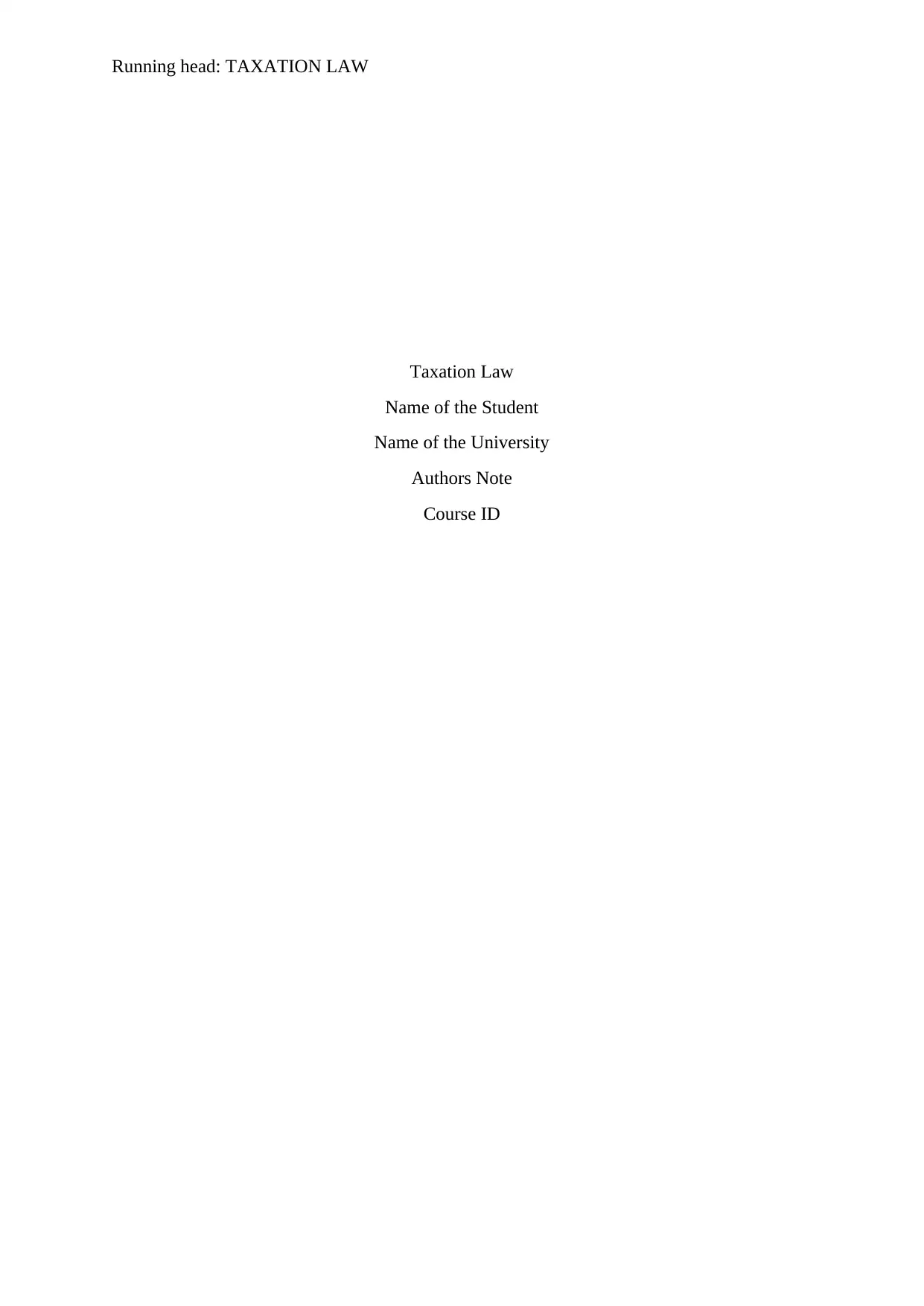
Running head: TAXATION LAW
Taxation Law
Name of the Student
Name of the University
Authors Note
Course ID
Taxation Law
Name of the Student
Name of the University
Authors Note
Course ID
Paraphrase This Document
Need a fresh take? Get an instant paraphrase of this document with our AI Paraphraser

1TAXATION LAW
Table of Contents
Answer to question 1:.................................................................................................................2
Answer to question 2:.................................................................................................................3
Answer to A:..........................................................................................................................3
Answer to B:..........................................................................................................................3
Answer C:...............................................................................................................................4
Answer D:..............................................................................................................................4
Answer E:...............................................................................................................................4
Answer F:...............................................................................................................................4
Answer G:..............................................................................................................................4
Answer H:..............................................................................................................................5
Answer I:................................................................................................................................5
Answer J:................................................................................................................................5
Answer to question 3:.................................................................................................................5
Answer to question 4:.................................................................................................................6
References:.................................................................................................................................8
Table of Contents
Answer to question 1:.................................................................................................................2
Answer to question 2:.................................................................................................................3
Answer to A:..........................................................................................................................3
Answer to B:..........................................................................................................................3
Answer C:...............................................................................................................................4
Answer D:..............................................................................................................................4
Answer E:...............................................................................................................................4
Answer F:...............................................................................................................................4
Answer G:..............................................................................................................................4
Answer H:..............................................................................................................................5
Answer I:................................................................................................................................5
Answer J:................................................................................................................................5
Answer to question 3:.................................................................................................................5
Answer to question 4:.................................................................................................................6
References:.................................................................................................................................8
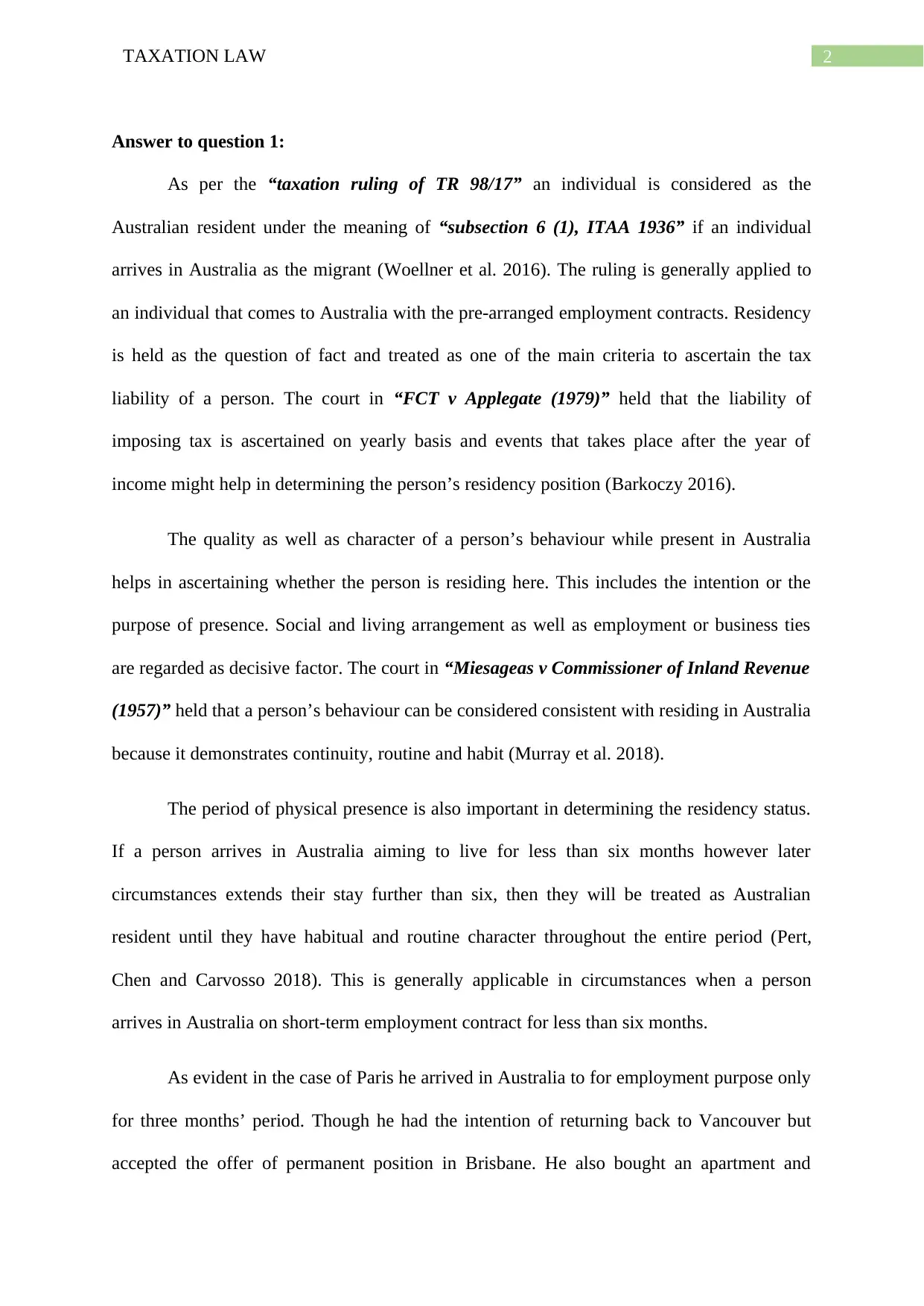
2TAXATION LAW
Answer to question 1:
As per the “taxation ruling of TR 98/17” an individual is considered as the
Australian resident under the meaning of “subsection 6 (1), ITAA 1936” if an individual
arrives in Australia as the migrant (Woellner et al. 2016). The ruling is generally applied to
an individual that comes to Australia with the pre-arranged employment contracts. Residency
is held as the question of fact and treated as one of the main criteria to ascertain the tax
liability of a person. The court in “FCT v Applegate (1979)” held that the liability of
imposing tax is ascertained on yearly basis and events that takes place after the year of
income might help in determining the person’s residency position (Barkoczy 2016).
The quality as well as character of a person’s behaviour while present in Australia
helps in ascertaining whether the person is residing here. This includes the intention or the
purpose of presence. Social and living arrangement as well as employment or business ties
are regarded as decisive factor. The court in “Miesageas v Commissioner of Inland Revenue
(1957)” held that a person’s behaviour can be considered consistent with residing in Australia
because it demonstrates continuity, routine and habit (Murray et al. 2018).
The period of physical presence is also important in determining the residency status.
If a person arrives in Australia aiming to live for less than six months however later
circumstances extends their stay further than six, then they will be treated as Australian
resident until they have habitual and routine character throughout the entire period (Pert,
Chen and Carvosso 2018). This is generally applicable in circumstances when a person
arrives in Australia on short-term employment contract for less than six months.
As evident in the case of Paris he arrived in Australia to for employment purpose only
for three months’ period. Though he had the intention of returning back to Vancouver but
accepted the offer of permanent position in Brisbane. He also bought an apartment and
Answer to question 1:
As per the “taxation ruling of TR 98/17” an individual is considered as the
Australian resident under the meaning of “subsection 6 (1), ITAA 1936” if an individual
arrives in Australia as the migrant (Woellner et al. 2016). The ruling is generally applied to
an individual that comes to Australia with the pre-arranged employment contracts. Residency
is held as the question of fact and treated as one of the main criteria to ascertain the tax
liability of a person. The court in “FCT v Applegate (1979)” held that the liability of
imposing tax is ascertained on yearly basis and events that takes place after the year of
income might help in determining the person’s residency position (Barkoczy 2016).
The quality as well as character of a person’s behaviour while present in Australia
helps in ascertaining whether the person is residing here. This includes the intention or the
purpose of presence. Social and living arrangement as well as employment or business ties
are regarded as decisive factor. The court in “Miesageas v Commissioner of Inland Revenue
(1957)” held that a person’s behaviour can be considered consistent with residing in Australia
because it demonstrates continuity, routine and habit (Murray et al. 2018).
The period of physical presence is also important in determining the residency status.
If a person arrives in Australia aiming to live for less than six months however later
circumstances extends their stay further than six, then they will be treated as Australian
resident until they have habitual and routine character throughout the entire period (Pert,
Chen and Carvosso 2018). This is generally applicable in circumstances when a person
arrives in Australia on short-term employment contract for less than six months.
As evident in the case of Paris he arrived in Australia to for employment purpose only
for three months’ period. Though he had the intention of returning back to Vancouver but
accepted the offer of permanent position in Brisbane. He also bought an apartment and
⊘ This is a preview!⊘
Do you want full access?
Subscribe today to unlock all pages.

Trusted by 1+ million students worldwide
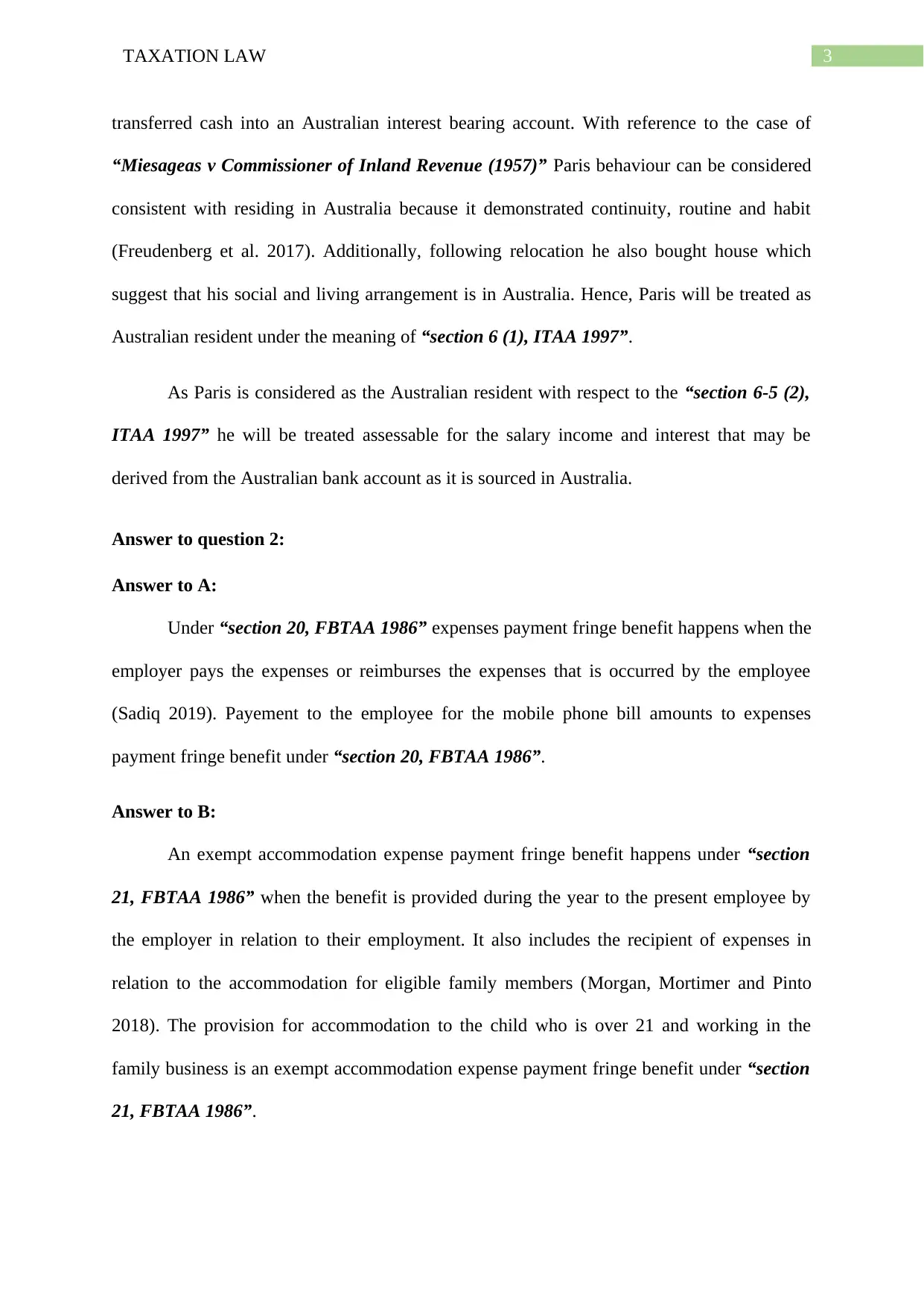
3TAXATION LAW
transferred cash into an Australian interest bearing account. With reference to the case of
“Miesageas v Commissioner of Inland Revenue (1957)” Paris behaviour can be considered
consistent with residing in Australia because it demonstrated continuity, routine and habit
(Freudenberg et al. 2017). Additionally, following relocation he also bought house which
suggest that his social and living arrangement is in Australia. Hence, Paris will be treated as
Australian resident under the meaning of “section 6 (1), ITAA 1997”.
As Paris is considered as the Australian resident with respect to the “section 6-5 (2),
ITAA 1997” he will be treated assessable for the salary income and interest that may be
derived from the Australian bank account as it is sourced in Australia.
Answer to question 2:
Answer to A:
Under “section 20, FBTAA 1986” expenses payment fringe benefit happens when the
employer pays the expenses or reimburses the expenses that is occurred by the employee
(Sadiq 2019). Payement to the employee for the mobile phone bill amounts to expenses
payment fringe benefit under “section 20, FBTAA 1986”.
Answer to B:
An exempt accommodation expense payment fringe benefit happens under “section
21, FBTAA 1986” when the benefit is provided during the year to the present employee by
the employer in relation to their employment. It also includes the recipient of expenses in
relation to the accommodation for eligible family members (Morgan, Mortimer and Pinto
2018). The provision for accommodation to the child who is over 21 and working in the
family business is an exempt accommodation expense payment fringe benefit under “section
21, FBTAA 1986”.
transferred cash into an Australian interest bearing account. With reference to the case of
“Miesageas v Commissioner of Inland Revenue (1957)” Paris behaviour can be considered
consistent with residing in Australia because it demonstrated continuity, routine and habit
(Freudenberg et al. 2017). Additionally, following relocation he also bought house which
suggest that his social and living arrangement is in Australia. Hence, Paris will be treated as
Australian resident under the meaning of “section 6 (1), ITAA 1997”.
As Paris is considered as the Australian resident with respect to the “section 6-5 (2),
ITAA 1997” he will be treated assessable for the salary income and interest that may be
derived from the Australian bank account as it is sourced in Australia.
Answer to question 2:
Answer to A:
Under “section 20, FBTAA 1986” expenses payment fringe benefit happens when the
employer pays the expenses or reimburses the expenses that is occurred by the employee
(Sadiq 2019). Payement to the employee for the mobile phone bill amounts to expenses
payment fringe benefit under “section 20, FBTAA 1986”.
Answer to B:
An exempt accommodation expense payment fringe benefit happens under “section
21, FBTAA 1986” when the benefit is provided during the year to the present employee by
the employer in relation to their employment. It also includes the recipient of expenses in
relation to the accommodation for eligible family members (Morgan, Mortimer and Pinto
2018). The provision for accommodation to the child who is over 21 and working in the
family business is an exempt accommodation expense payment fringe benefit under “section
21, FBTAA 1986”.
Paraphrase This Document
Need a fresh take? Get an instant paraphrase of this document with our AI Paraphraser
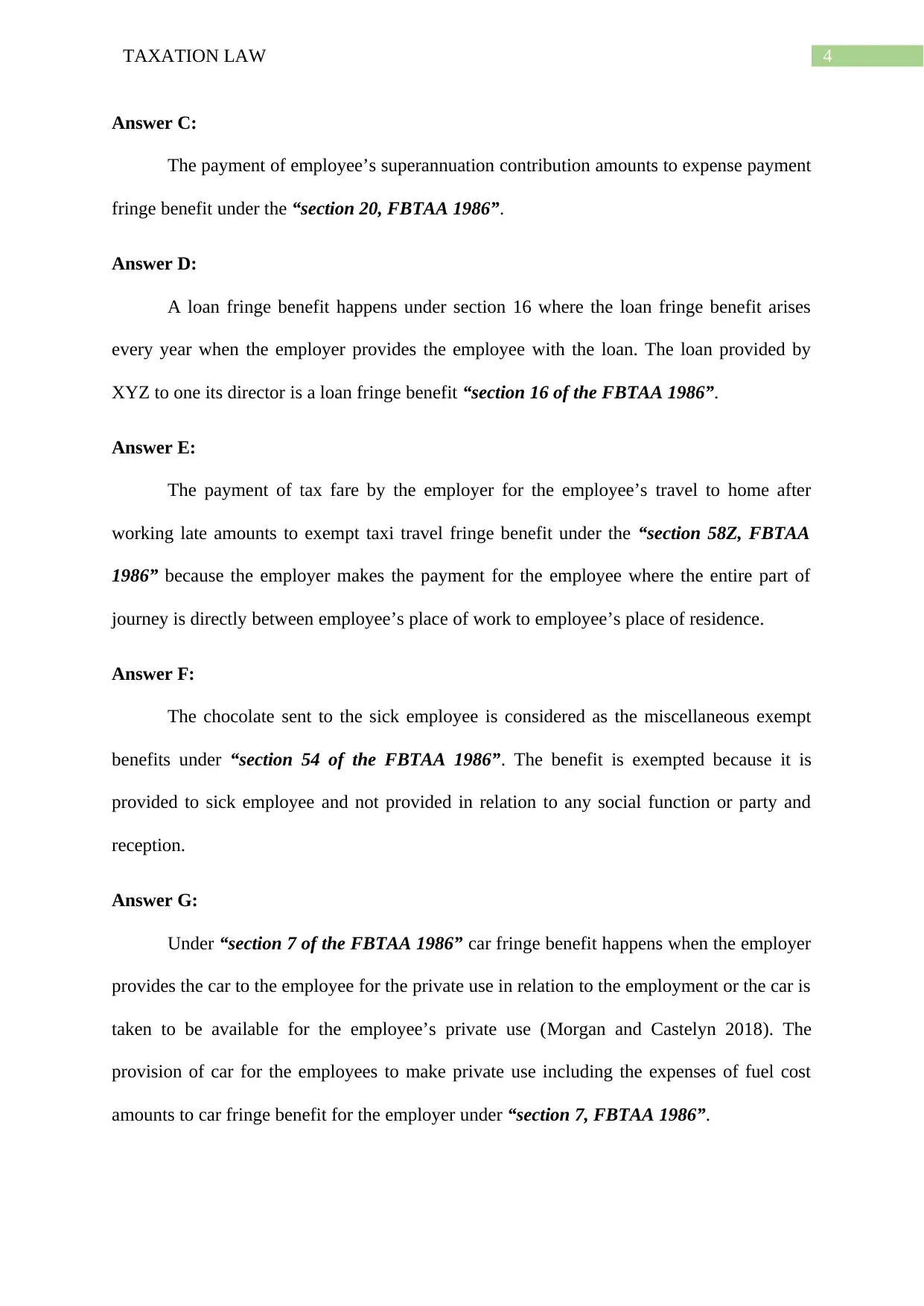
4TAXATION LAW
Answer C:
The payment of employee’s superannuation contribution amounts to expense payment
fringe benefit under the “section 20, FBTAA 1986”.
Answer D:
A loan fringe benefit happens under section 16 where the loan fringe benefit arises
every year when the employer provides the employee with the loan. The loan provided by
XYZ to one its director is a loan fringe benefit “section 16 of the FBTAA 1986”.
Answer E:
The payment of tax fare by the employer for the employee’s travel to home after
working late amounts to exempt taxi travel fringe benefit under the “section 58Z, FBTAA
1986” because the employer makes the payment for the employee where the entire part of
journey is directly between employee’s place of work to employee’s place of residence.
Answer F:
The chocolate sent to the sick employee is considered as the miscellaneous exempt
benefits under “section 54 of the FBTAA 1986”. The benefit is exempted because it is
provided to sick employee and not provided in relation to any social function or party and
reception.
Answer G:
Under “section 7 of the FBTAA 1986” car fringe benefit happens when the employer
provides the car to the employee for the private use in relation to the employment or the car is
taken to be available for the employee’s private use (Morgan and Castelyn 2018). The
provision of car for the employees to make private use including the expenses of fuel cost
amounts to car fringe benefit for the employer under “section 7, FBTAA 1986”.
Answer C:
The payment of employee’s superannuation contribution amounts to expense payment
fringe benefit under the “section 20, FBTAA 1986”.
Answer D:
A loan fringe benefit happens under section 16 where the loan fringe benefit arises
every year when the employer provides the employee with the loan. The loan provided by
XYZ to one its director is a loan fringe benefit “section 16 of the FBTAA 1986”.
Answer E:
The payment of tax fare by the employer for the employee’s travel to home after
working late amounts to exempt taxi travel fringe benefit under the “section 58Z, FBTAA
1986” because the employer makes the payment for the employee where the entire part of
journey is directly between employee’s place of work to employee’s place of residence.
Answer F:
The chocolate sent to the sick employee is considered as the miscellaneous exempt
benefits under “section 54 of the FBTAA 1986”. The benefit is exempted because it is
provided to sick employee and not provided in relation to any social function or party and
reception.
Answer G:
Under “section 7 of the FBTAA 1986” car fringe benefit happens when the employer
provides the car to the employee for the private use in relation to the employment or the car is
taken to be available for the employee’s private use (Morgan and Castelyn 2018). The
provision of car for the employees to make private use including the expenses of fuel cost
amounts to car fringe benefit for the employer under “section 7, FBTAA 1986”.
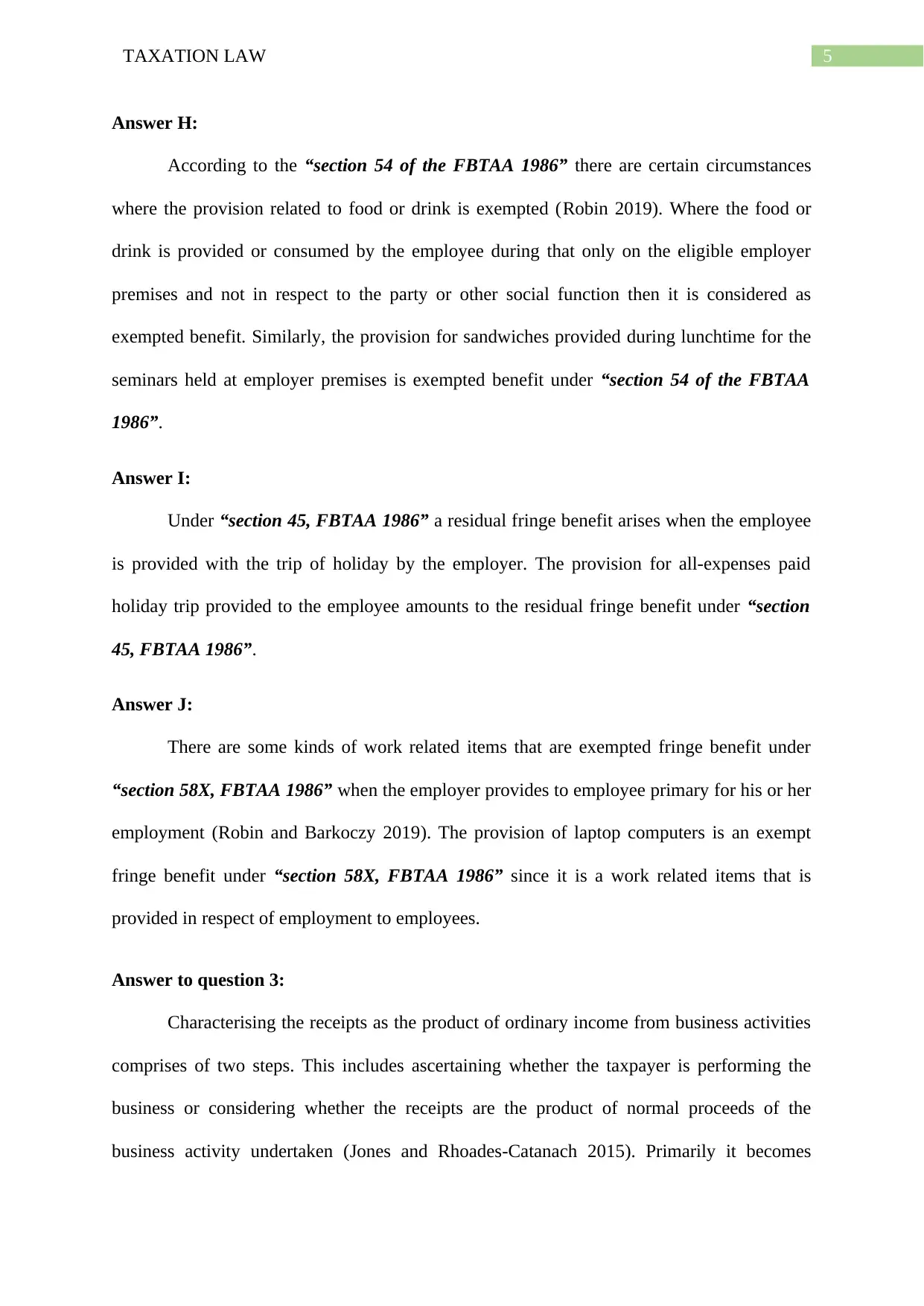
5TAXATION LAW
Answer H:
According to the “section 54 of the FBTAA 1986” there are certain circumstances
where the provision related to food or drink is exempted (Robin 2019). Where the food or
drink is provided or consumed by the employee during that only on the eligible employer
premises and not in respect to the party or other social function then it is considered as
exempted benefit. Similarly, the provision for sandwiches provided during lunchtime for the
seminars held at employer premises is exempted benefit under “section 54 of the FBTAA
1986”.
Answer I:
Under “section 45, FBTAA 1986” a residual fringe benefit arises when the employee
is provided with the trip of holiday by the employer. The provision for all-expenses paid
holiday trip provided to the employee amounts to the residual fringe benefit under “section
45, FBTAA 1986”.
Answer J:
There are some kinds of work related items that are exempted fringe benefit under
“section 58X, FBTAA 1986” when the employer provides to employee primary for his or her
employment (Robin and Barkoczy 2019). The provision of laptop computers is an exempt
fringe benefit under “section 58X, FBTAA 1986” since it is a work related items that is
provided in respect of employment to employees.
Answer to question 3:
Characterising the receipts as the product of ordinary income from business activities
comprises of two steps. This includes ascertaining whether the taxpayer is performing the
business or considering whether the receipts are the product of normal proceeds of the
business activity undertaken (Jones and Rhoades-Catanach 2015). Primarily it becomes
Answer H:
According to the “section 54 of the FBTAA 1986” there are certain circumstances
where the provision related to food or drink is exempted (Robin 2019). Where the food or
drink is provided or consumed by the employee during that only on the eligible employer
premises and not in respect to the party or other social function then it is considered as
exempted benefit. Similarly, the provision for sandwiches provided during lunchtime for the
seminars held at employer premises is exempted benefit under “section 54 of the FBTAA
1986”.
Answer I:
Under “section 45, FBTAA 1986” a residual fringe benefit arises when the employee
is provided with the trip of holiday by the employer. The provision for all-expenses paid
holiday trip provided to the employee amounts to the residual fringe benefit under “section
45, FBTAA 1986”.
Answer J:
There are some kinds of work related items that are exempted fringe benefit under
“section 58X, FBTAA 1986” when the employer provides to employee primary for his or her
employment (Robin and Barkoczy 2019). The provision of laptop computers is an exempt
fringe benefit under “section 58X, FBTAA 1986” since it is a work related items that is
provided in respect of employment to employees.
Answer to question 3:
Characterising the receipts as the product of ordinary income from business activities
comprises of two steps. This includes ascertaining whether the taxpayer is performing the
business or considering whether the receipts are the product of normal proceeds of the
business activity undertaken (Jones and Rhoades-Catanach 2015). Primarily it becomes
⊘ This is a preview!⊘
Do you want full access?
Subscribe today to unlock all pages.

Trusted by 1+ million students worldwide
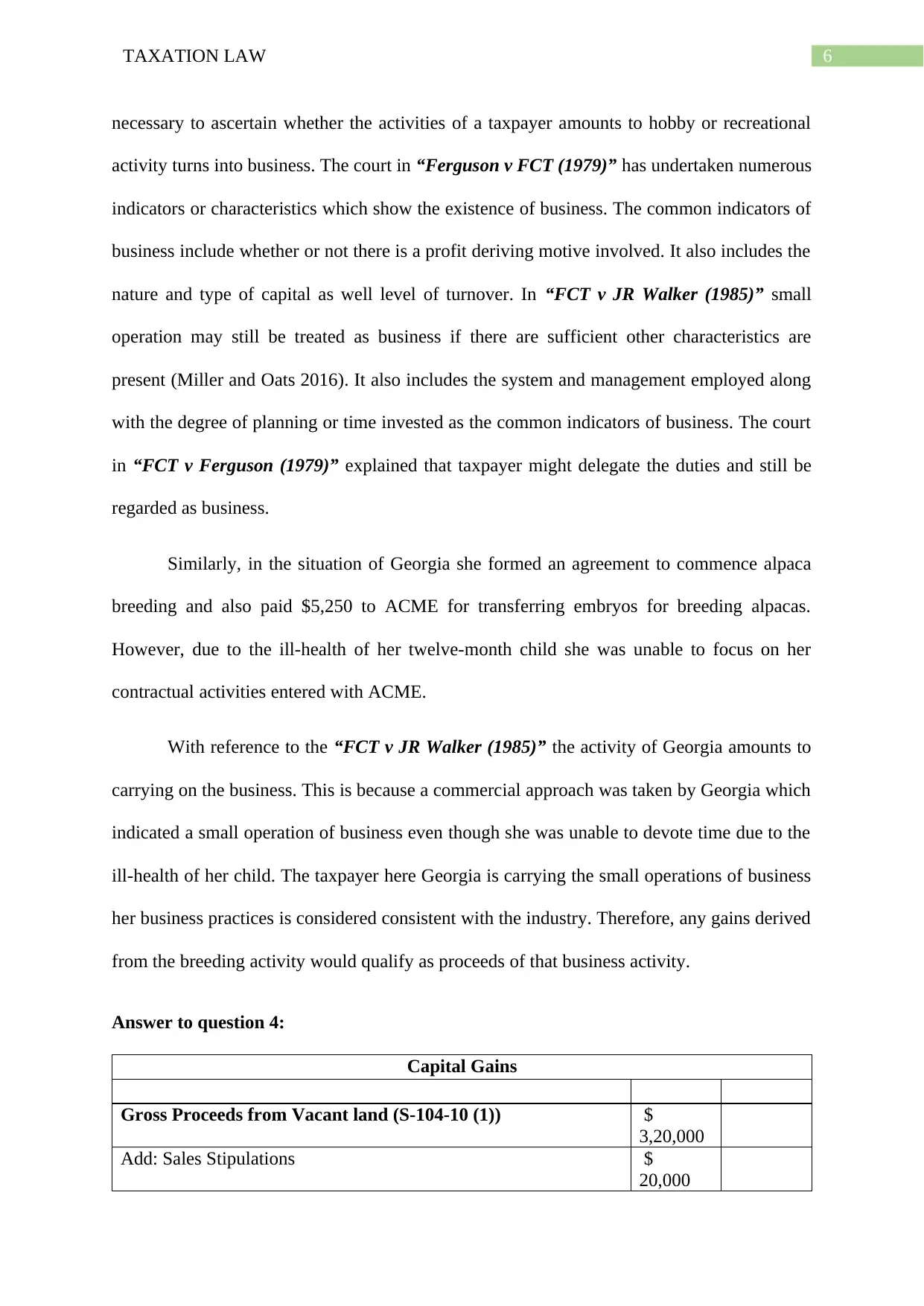
6TAXATION LAW
necessary to ascertain whether the activities of a taxpayer amounts to hobby or recreational
activity turns into business. The court in “Ferguson v FCT (1979)” has undertaken numerous
indicators or characteristics which show the existence of business. The common indicators of
business include whether or not there is a profit deriving motive involved. It also includes the
nature and type of capital as well level of turnover. In “FCT v JR Walker (1985)” small
operation may still be treated as business if there are sufficient other characteristics are
present (Miller and Oats 2016). It also includes the system and management employed along
with the degree of planning or time invested as the common indicators of business. The court
in “FCT v Ferguson (1979)” explained that taxpayer might delegate the duties and still be
regarded as business.
Similarly, in the situation of Georgia she formed an agreement to commence alpaca
breeding and also paid $5,250 to ACME for transferring embryos for breeding alpacas.
However, due to the ill-health of her twelve-month child she was unable to focus on her
contractual activities entered with ACME.
With reference to the “FCT v JR Walker (1985)” the activity of Georgia amounts to
carrying on the business. This is because a commercial approach was taken by Georgia which
indicated a small operation of business even though she was unable to devote time due to the
ill-health of her child. The taxpayer here Georgia is carrying the small operations of business
her business practices is considered consistent with the industry. Therefore, any gains derived
from the breeding activity would qualify as proceeds of that business activity.
Answer to question 4:
Capital Gains
Gross Proceeds from Vacant land (S-104-10 (1)) $
3,20,000
Add: Sales Stipulations $
20,000
necessary to ascertain whether the activities of a taxpayer amounts to hobby or recreational
activity turns into business. The court in “Ferguson v FCT (1979)” has undertaken numerous
indicators or characteristics which show the existence of business. The common indicators of
business include whether or not there is a profit deriving motive involved. It also includes the
nature and type of capital as well level of turnover. In “FCT v JR Walker (1985)” small
operation may still be treated as business if there are sufficient other characteristics are
present (Miller and Oats 2016). It also includes the system and management employed along
with the degree of planning or time invested as the common indicators of business. The court
in “FCT v Ferguson (1979)” explained that taxpayer might delegate the duties and still be
regarded as business.
Similarly, in the situation of Georgia she formed an agreement to commence alpaca
breeding and also paid $5,250 to ACME for transferring embryos for breeding alpacas.
However, due to the ill-health of her twelve-month child she was unable to focus on her
contractual activities entered with ACME.
With reference to the “FCT v JR Walker (1985)” the activity of Georgia amounts to
carrying on the business. This is because a commercial approach was taken by Georgia which
indicated a small operation of business even though she was unable to devote time due to the
ill-health of her child. The taxpayer here Georgia is carrying the small operations of business
her business practices is considered consistent with the industry. Therefore, any gains derived
from the breeding activity would qualify as proceeds of that business activity.
Answer to question 4:
Capital Gains
Gross Proceeds from Vacant land (S-104-10 (1)) $
3,20,000
Add: Sales Stipulations $
20,000
Paraphrase This Document
Need a fresh take? Get an instant paraphrase of this document with our AI Paraphraser
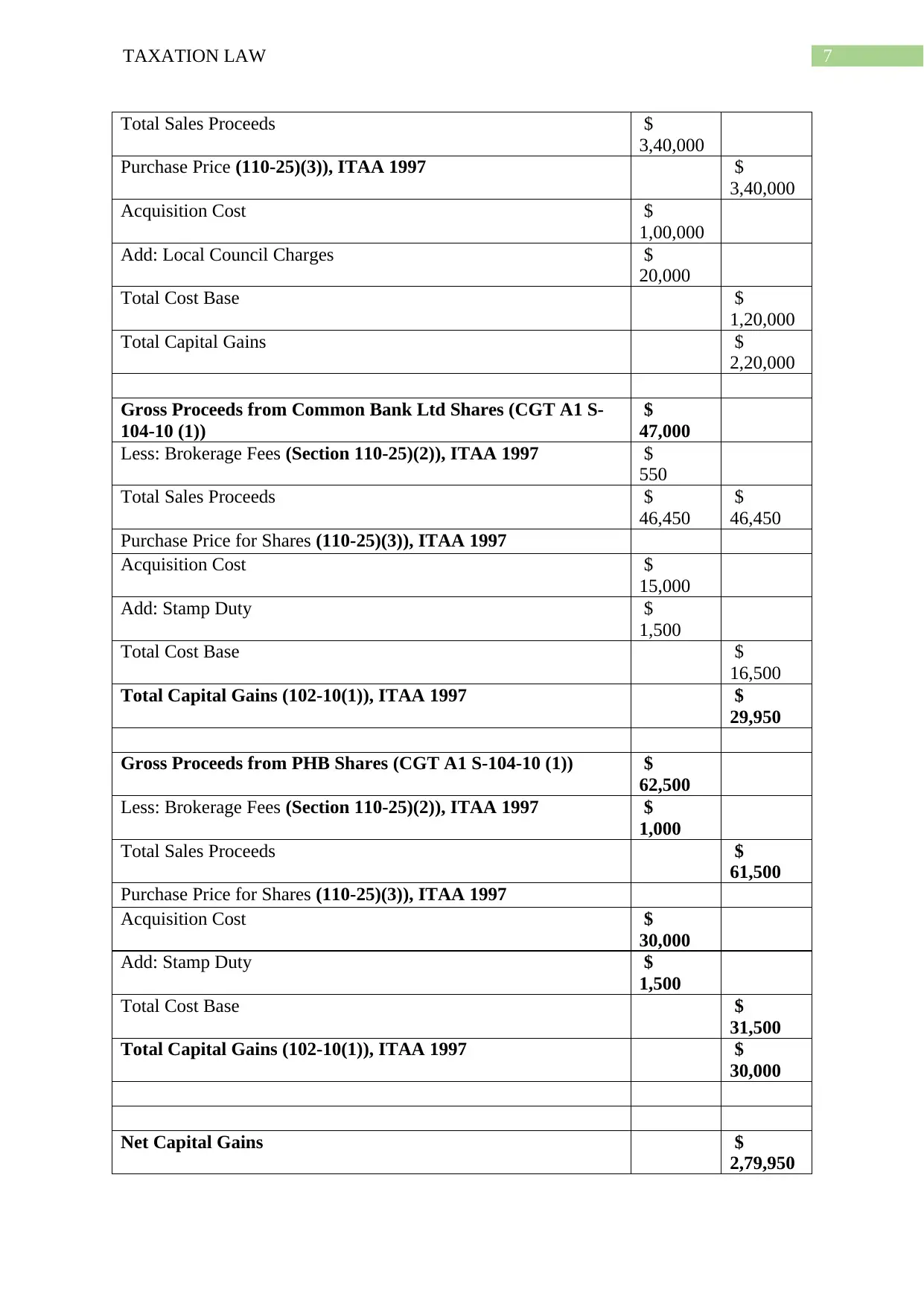
7TAXATION LAW
Total Sales Proceeds $
3,40,000
Purchase Price (110-25)(3)), ITAA 1997 $
3,40,000
Acquisition Cost $
1,00,000
Add: Local Council Charges $
20,000
Total Cost Base $
1,20,000
Total Capital Gains $
2,20,000
Gross Proceeds from Common Bank Ltd Shares (CGT A1 S-
104-10 (1))
$
47,000
Less: Brokerage Fees (Section 110-25)(2)), ITAA 1997 $
550
Total Sales Proceeds $
46,450
$
46,450
Purchase Price for Shares (110-25)(3)), ITAA 1997
Acquisition Cost $
15,000
Add: Stamp Duty $
1,500
Total Cost Base $
16,500
Total Capital Gains (102-10(1)), ITAA 1997 $
29,950
Gross Proceeds from PHB Shares (CGT A1 S-104-10 (1)) $
62,500
Less: Brokerage Fees (Section 110-25)(2)), ITAA 1997 $
1,000
Total Sales Proceeds $
61,500
Purchase Price for Shares (110-25)(3)), ITAA 1997
Acquisition Cost $
30,000
Add: Stamp Duty $
1,500
Total Cost Base $
31,500
Total Capital Gains (102-10(1)), ITAA 1997 $
30,000
Net Capital Gains $
2,79,950
Total Sales Proceeds $
3,40,000
Purchase Price (110-25)(3)), ITAA 1997 $
3,40,000
Acquisition Cost $
1,00,000
Add: Local Council Charges $
20,000
Total Cost Base $
1,20,000
Total Capital Gains $
2,20,000
Gross Proceeds from Common Bank Ltd Shares (CGT A1 S-
104-10 (1))
$
47,000
Less: Brokerage Fees (Section 110-25)(2)), ITAA 1997 $
550
Total Sales Proceeds $
46,450
$
46,450
Purchase Price for Shares (110-25)(3)), ITAA 1997
Acquisition Cost $
15,000
Add: Stamp Duty $
1,500
Total Cost Base $
16,500
Total Capital Gains (102-10(1)), ITAA 1997 $
29,950
Gross Proceeds from PHB Shares (CGT A1 S-104-10 (1)) $
62,500
Less: Brokerage Fees (Section 110-25)(2)), ITAA 1997 $
1,000
Total Sales Proceeds $
61,500
Purchase Price for Shares (110-25)(3)), ITAA 1997
Acquisition Cost $
30,000
Add: Stamp Duty $
1,500
Total Cost Base $
31,500
Total Capital Gains (102-10(1)), ITAA 1997 $
30,000
Net Capital Gains $
2,79,950
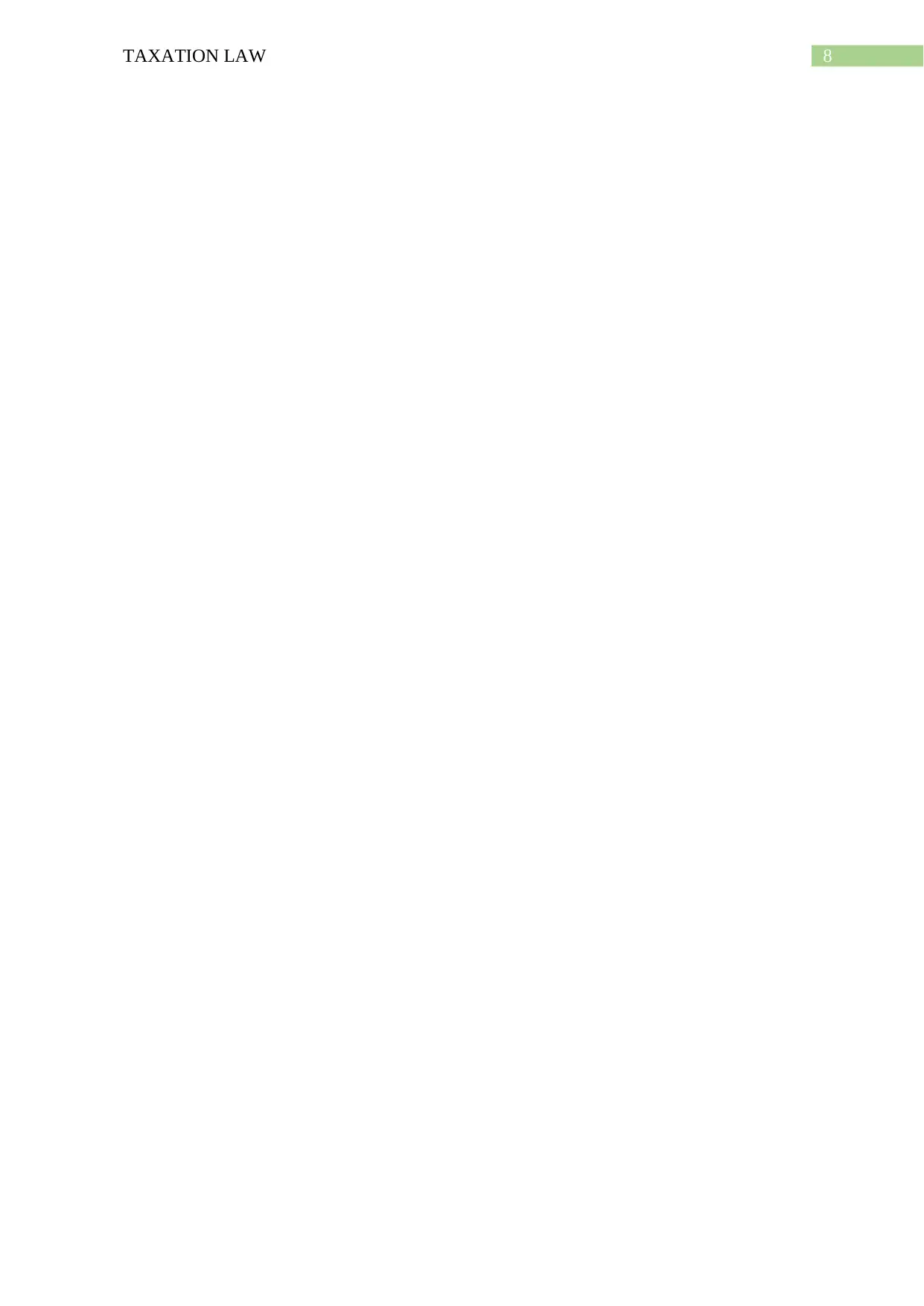
8TAXATION LAW
⊘ This is a preview!⊘
Do you want full access?
Subscribe today to unlock all pages.

Trusted by 1+ million students worldwide
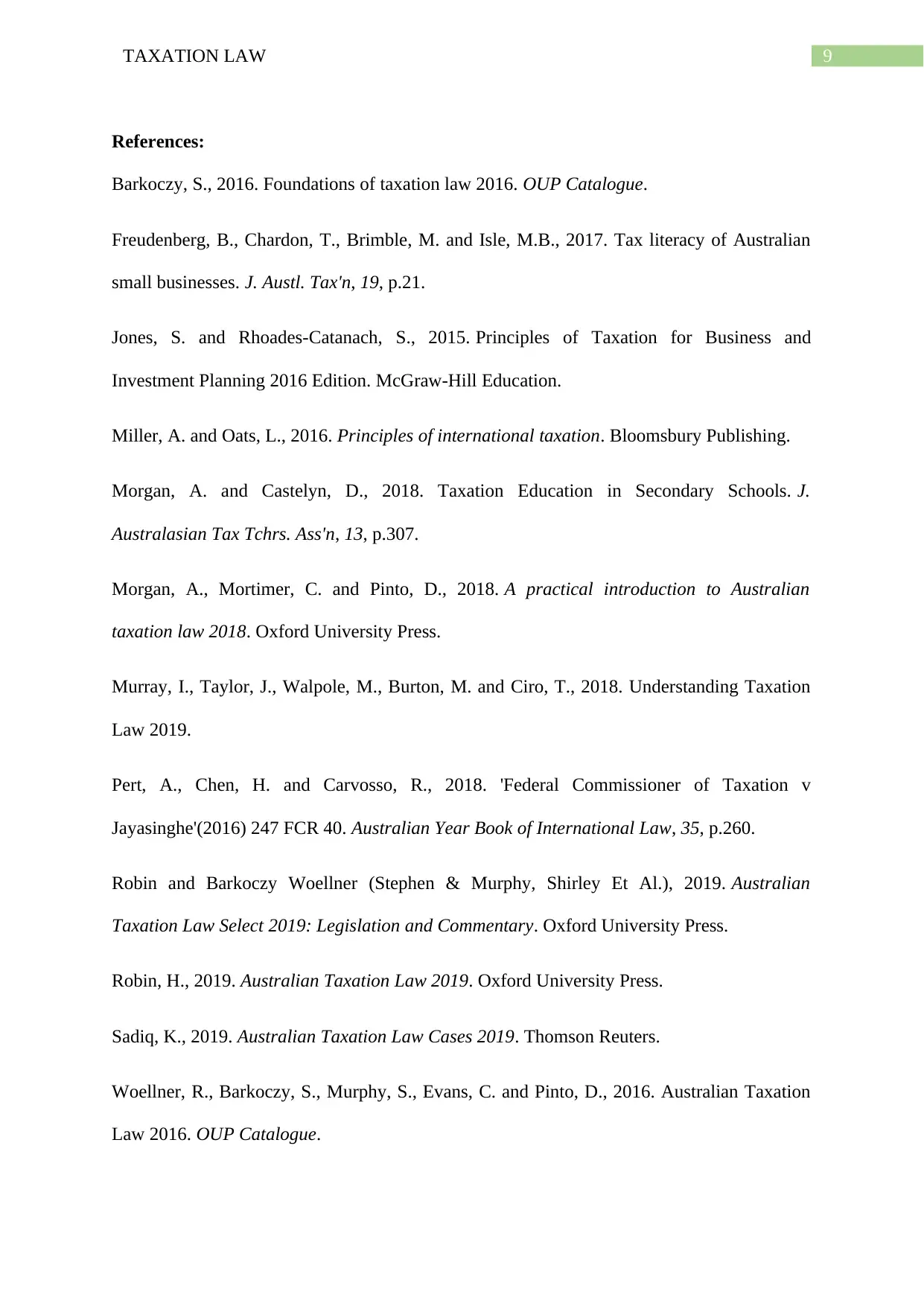
9TAXATION LAW
References:
Barkoczy, S., 2016. Foundations of taxation law 2016. OUP Catalogue.
Freudenberg, B., Chardon, T., Brimble, M. and Isle, M.B., 2017. Tax literacy of Australian
small businesses. J. Austl. Tax'n, 19, p.21.
Jones, S. and Rhoades-Catanach, S., 2015. Principles of Taxation for Business and
Investment Planning 2016 Edition. McGraw-Hill Education.
Miller, A. and Oats, L., 2016. Principles of international taxation. Bloomsbury Publishing.
Morgan, A. and Castelyn, D., 2018. Taxation Education in Secondary Schools. J.
Australasian Tax Tchrs. Ass'n, 13, p.307.
Morgan, A., Mortimer, C. and Pinto, D., 2018. A practical introduction to Australian
taxation law 2018. Oxford University Press.
Murray, I., Taylor, J., Walpole, M., Burton, M. and Ciro, T., 2018. Understanding Taxation
Law 2019.
Pert, A., Chen, H. and Carvosso, R., 2018. 'Federal Commissioner of Taxation v
Jayasinghe'(2016) 247 FCR 40. Australian Year Book of International Law, 35, p.260.
Robin and Barkoczy Woellner (Stephen & Murphy, Shirley Et Al.), 2019. Australian
Taxation Law Select 2019: Legislation and Commentary. Oxford University Press.
Robin, H., 2019. Australian Taxation Law 2019. Oxford University Press.
Sadiq, K., 2019. Australian Taxation Law Cases 2019. Thomson Reuters.
Woellner, R., Barkoczy, S., Murphy, S., Evans, C. and Pinto, D., 2016. Australian Taxation
Law 2016. OUP Catalogue.
References:
Barkoczy, S., 2016. Foundations of taxation law 2016. OUP Catalogue.
Freudenberg, B., Chardon, T., Brimble, M. and Isle, M.B., 2017. Tax literacy of Australian
small businesses. J. Austl. Tax'n, 19, p.21.
Jones, S. and Rhoades-Catanach, S., 2015. Principles of Taxation for Business and
Investment Planning 2016 Edition. McGraw-Hill Education.
Miller, A. and Oats, L., 2016. Principles of international taxation. Bloomsbury Publishing.
Morgan, A. and Castelyn, D., 2018. Taxation Education in Secondary Schools. J.
Australasian Tax Tchrs. Ass'n, 13, p.307.
Morgan, A., Mortimer, C. and Pinto, D., 2018. A practical introduction to Australian
taxation law 2018. Oxford University Press.
Murray, I., Taylor, J., Walpole, M., Burton, M. and Ciro, T., 2018. Understanding Taxation
Law 2019.
Pert, A., Chen, H. and Carvosso, R., 2018. 'Federal Commissioner of Taxation v
Jayasinghe'(2016) 247 FCR 40. Australian Year Book of International Law, 35, p.260.
Robin and Barkoczy Woellner (Stephen & Murphy, Shirley Et Al.), 2019. Australian
Taxation Law Select 2019: Legislation and Commentary. Oxford University Press.
Robin, H., 2019. Australian Taxation Law 2019. Oxford University Press.
Sadiq, K., 2019. Australian Taxation Law Cases 2019. Thomson Reuters.
Woellner, R., Barkoczy, S., Murphy, S., Evans, C. and Pinto, D., 2016. Australian Taxation
Law 2016. OUP Catalogue.
Paraphrase This Document
Need a fresh take? Get an instant paraphrase of this document with our AI Paraphraser
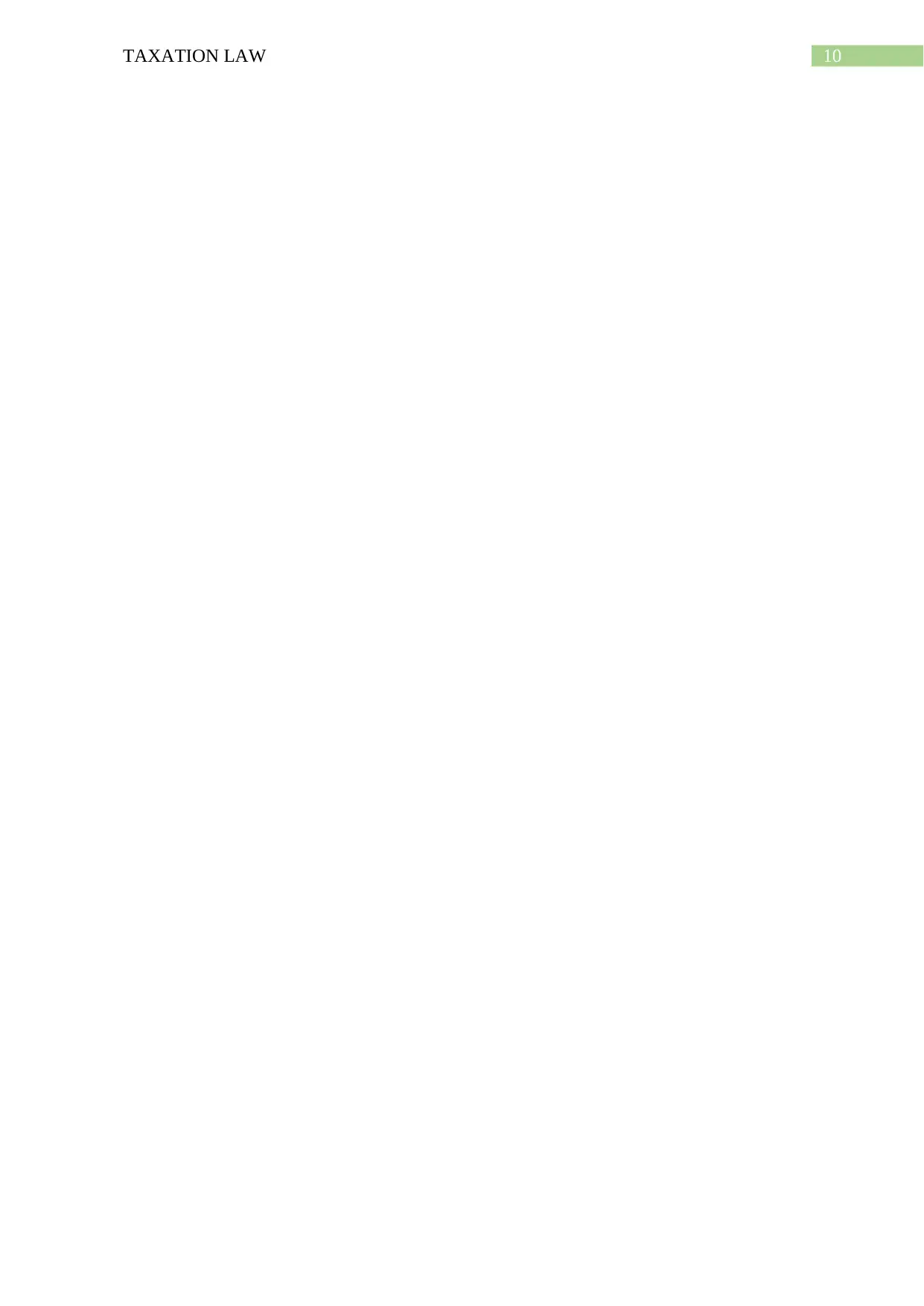
10TAXATION LAW
1 out of 11
Related Documents
Your All-in-One AI-Powered Toolkit for Academic Success.
+13062052269
info@desklib.com
Available 24*7 on WhatsApp / Email
![[object Object]](/_next/static/media/star-bottom.7253800d.svg)
Unlock your academic potential
Copyright © 2020–2025 A2Z Services. All Rights Reserved. Developed and managed by ZUCOL.





